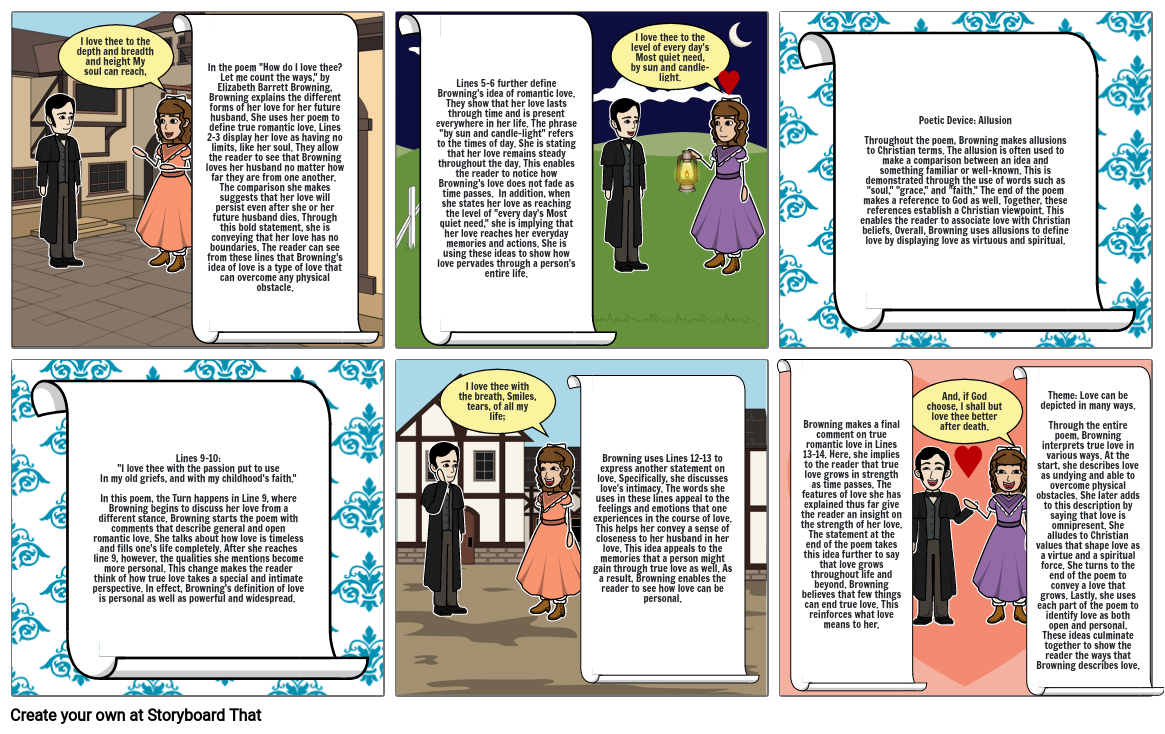Let me count the ways

Storyboard Tekst
- I love thee to the depth and breadth and height My soul can reach,
- In the poem "How do I love thee? Let me count the ways," by Elizabeth Barrett Browning, Browning explains the different forms of her love for her future husband. She uses her poem to define true romantic love. Lines 2-3 display her love as having no limits, like her soul. They allow the reader to see that Browning loves her husband no matter how far they are from one another. The comparison she makes suggests that her love will persist even after she or her future husband dies. Through this bold statement, she is conveying that her love has no boundaries. The reader can see from these lines that Browning's idea of love is a type of love that can overcome any physical obstacle.
- Lines 5-6 further define Browning's idea of romantic love. They show that her love lasts through time and is present everywhere in her life. The phrase "by sun and candle-light" refers to the times of day. She is stating that her love remains steady throughout the day. This enables the reader to notice how Browning's love does not fade as time passes. In addition, when she states her love as reaching the level of "every day's Most quiet need," she is implying that her love reaches her everyday memories and actions. She is using these ideas to show how love pervades through a person's entire life.
- I love thee to the level of every day's Most quiet need, by sun and candle-light.
- Poetic Device: AllusionThroughout the poem, Browning makes allusions to Christian terms. The allusion is often used to make a comparison between an idea and something familiar or well-known. This is demonstrated through the use of words such as "soul," "grace," and "faith." The end of the poem makes a reference to God as well. Together, these references establish a Christian viewpoint. This enables the reader to associate love with Christian beliefs. Overall, Browning uses allusions to define love by displaying love as virtuous and spiritual.
- Lines 9-10:"I love thee with the passion put to use In my old griefs, and with my childhood's faith."In this poem, the Turn happens in Line 9, where Browning begins to discuss her love from a different stance. Browning starts the poem with comments that describe general and open romantic love. She talks about how love is timeless and fills one's life completely. After she reaches line 9, however, the qualities she mentions become more personal. This change makes the reader think of how true love takes a special and intimate perspective. In effect, Browning's definition of love is personal as well as powerful and widespread.
- I love thee with the breath, Smiles, tears, of all my life;
- Browning uses Lines 12-13 to express another statement on love. Specifically, she discusses love's intimacy. The words she uses in these lines appeal to the feelings and emotions that one experiences in the course of love. This helps her convey a sense of closeness to her husband in her love. This idea appeals to the memories that a person might gain through true love as well. As a result, Browning enables the reader to see how love can be personal.
- Browning makes a final comment on true romantic love in Lines 13-14. Here, she implies to the reader that true love grows in strength as time passes. The features of love she has explained thus far give the reader an insight on the strength of her love. The statement at the end of the poem takes this idea further to say that love grows throughout life and beyond. Browning believes that few things can end true love. This reinforces what love means to her.
- And, if God choose, I shall but love thee better after death.
- Theme: Love can be depicted in many ways.Through the entire poem, Browning interprets true love in various ways. At the start, she describes love as undying and able to overcome physical obstacles. She later adds to this description by saying that love is omnipresent. She alludes to Christian values that shape love as a virtue and a spiritual force. She turns to the end of the poem to convey a love that grows. Lastly, she uses each part of the poem to identify love as both open and personal. These ideas culminate together to show the reader the ways that Browning describes love.
Over 30 millioner storyboards opprettet

